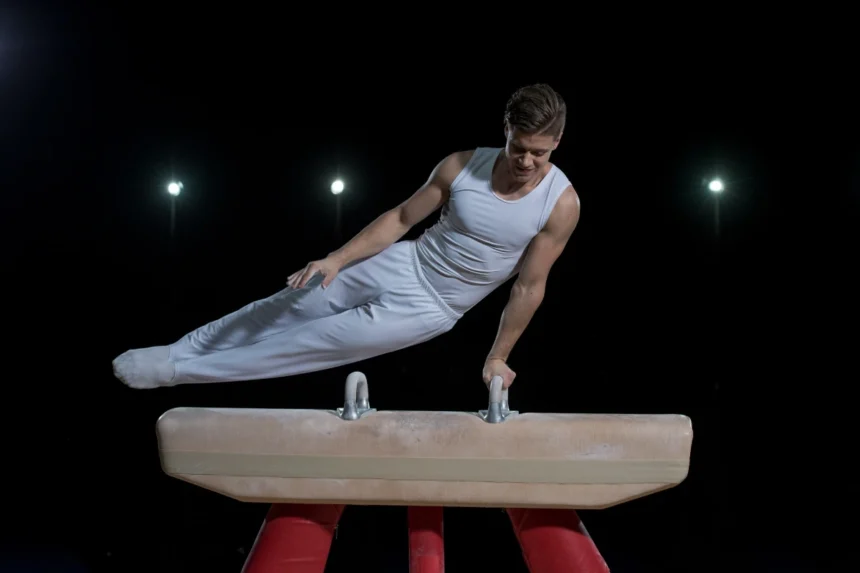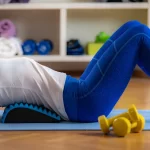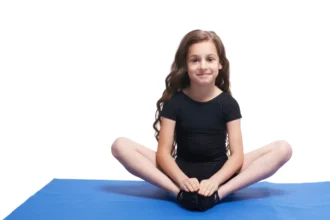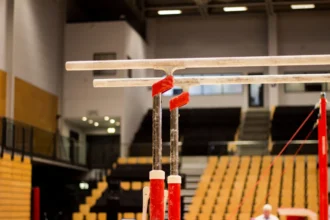Men’s Artistic Gymnastics (MAG) in the United States is structured under the USA Gymnastics Men’s Development Program (2021–2029 cycle). Levels 1–10 form a progression that begins with basic movement literacy and builds toward NCAA and Junior Elite competition.
- Men’s Gymnastics Apparatus (MAG Events)
- Levels 1–2: Essential Elements (Pre-Competitive)
- Level 3: First Competitive Compulsory Level
- Level 4: Compulsory Development
- Level 5: Advanced Compulsory
- Level 6: Capstone Compulsory
- Level 7: Simplified Optional
- Level 8: Full Optional Development
- Level 9: Advanced Optional (Junior FIG-Style)
- Level 10: Top of the Development Program
- Ages, Mobility, and Divisions: What to Know
- Common Questions (Fast Answers)
- Official USA Gymnastics Sources
Below is a clear, level-by-level breakdown of what gymnasts are typically expected to develop at each stage.
Men’s Gymnastics Apparatus (MAG Events)
Men compete on six apparatus, always in the same Olympic order:
- Floor Exercise (FX): Tumbling, strength elements, flexibility, and endurance
- Pommel Horse (PH): Circles, flairs, scissors, turns, and travel
- Still Rings (SR): Strength holds, controlled swings, and powerful dismounts
- Vault (VT): Speed, blocking technique, body position, and landing control
- Parallel Bars (PB): Support swings, handstands, transitions, and releases
- High Bar (HB): Kips, giants, release skills, and dismounts
Levels 1–2: Essential Elements (Pre-Competitive)
Purpose: Build movement literacy and foundational strength
Competition: Typically non-competitive or in-house developmental
Levels 1–2 are often referred to as Essential Elements rather than formal competition levels. Many gyms use them as a preparation phase before athletes enter sanctioned competition at Level 3.
Common Focus Areas
- Basic body shapes (tuck, pike, straddle, hollow, arch)
- Rolls and safe landing mechanics
- Handstand preparation
- Hanging and support strength
- Introduction to swings and circles
Event Emphasis
- Floor: Forward/backward rolls, straight jumps, levers, basic handstand shapes
- Pommel / Mushroom: Leg swings, circle preparation, rhythm awareness
- Rings: Support holds, bent-arm hangs, swing basics
- Vault: Board contact drills, jumps onto mats
- Parallel Bars: Front support and swing preparation
- High Bar: Long hangs, grip development, kip preparation
Note: Most boys do not compete Levels 1–2 at sanctioned meets.
Level 3: First Competitive Compulsory Level
Style: Standardized compulsory routines
Focus: Posture, body lines, control, and timing
Level 3 is where most boys enter formal competition. All athletes perform the same routines, and judging emphasizes execution quality over difficulty.
Typical Skill Expectations
- Floor: Handstands, rolls, cartwheel and round-off mechanics
- Pommel / Mushroom: Double-leg circle basics
- Rings: Support shapes, inverted hangs, controlled swings
- Vault: Straight jump vault emphasizing run, hurdle, and board contact
- Parallel Bars: Support swings and shoulder stands
- High Bar: Long-hang swings and basic cast actions
Scoring Model: Compulsory format, with deductions for execution errors and bonuses for precision and control.
Level 4: Compulsory Development
Purpose: Refine mechanics and increase consistency
Level 4 builds directly on Level 3 by increasing skill volume and control while reinforcing compulsory standards.
Key Progressions
- Floor: Back extension rolls, stronger handstand positions
- Pommel: Increased circle volume and early travel concepts
- Rings: More stable supports and controlled inversions
- Vault: Handstand flat-back vault (handspring over the table is not yet standard)
- Parallel Bars & High Bar: Improved swing amplitude and rhythm
The goal at this level is clean, repeatable execution, not risk-taking.
Level 5: Advanced Compulsory
Purpose: Prepare athletes for optional gymnastics
Level 5 routines are longer and more physically demanding. Execution standards rise sharply, and athletes begin to show the strength base needed for optionals.
Typical Highlights
- Floor: Dive rolls, press handstands, round-off → back handspring connections
- Pommel: Full circles, scissors, and turns
- Rings: Swing development with early strength preparation
- Vault: Front handspring over the vault table (first true table vault)
- Parallel Bars: Swings toward handstand, basket swing actions
- High Bar: Long-hang swings and flyaway dismounts
Level 6: Capstone Compulsory
Purpose: Final compulsory level before optionals
Level 6 bridges compulsory and optional gymnastics. Some gyms use it extensively, while others advance athletes directly from Level 5 to Level 7 based on readiness.
Focus Areas
- Floor: Clean tumbling lines (e.g., RO–BHS–BHS)
- Pommel: Strong circle and flair foundations
- Rings: Confident swings with basic strength holds
- Vault: Consistent handspring-style vaults
- Parallel Bars & High Bar: Connected swing work preparing for giants
Level 7: Simplified Optional
Purpose: Introduction to optional routine construction
Level 7 is the gymnast’s first exposure to optional routines, built from lower-difficulty FIG-based elements under USAG Development Program guidelines.
Typical Requirements (Simplified)
- Shorter routines with limited counting skills
- Required element groups across each event
- A minimum-value dismount
- No emphasis on start-value bonuses
Event Expectations
- Floor: Single salto passes, back handspring connections
- Pommel: Circles with limited travel
- Rings: Swings above horizontal, L-holds or tuck strength shapes
- Vault: Handspring front tuck or pike families
- Parallel Bars: Support swings and early giant actions
- High Bar: Giants and tap swing development
Level 8: Full Optional Development
Purpose: Strength, rhythm, and composition refinement
Level 8 routines are fully optional and generally follow Junior FIG-style structure with USAG modifications.
Key Characteristics
- Greater emphasis on swing amplitude and rhythm
- Stronger strength positions on rings
- Increased tumbling difficulty on floor
- Vault difficulty remains moderate compared to Levels 9–10
Note: While pommel-less horse is sometimes used in training or modified meets, official competition uses the standard pommel horse.
Level 9: Advanced Optional (Junior FIG-Style)
Purpose: High difficulty with execution consistency
Level 9 marks a major step up in difficulty and routine expectations. Athletes typically perform longer routines with more demanding dismounts.
Typical Skill Profile
- Floor: Double saltos, twisting layouts, combination passes
- Pommel: Travel sequences, Stockli-type skills, Russians
- Rings: Strength-to-swing transitions, double salto dismounts
- Vault: Tsukahara and Kasamatsu families
- Parallel Bars: Giant swings, early Healy-family skills
- High Bar: Release moves and advanced dismounts
Level 10: Top of the Development Program
Purpose: Prepare for NCAA, Junior Elite, or elite competition
Level 10 represents the highest level of the Men’s Development Program. Routines closely resemble Junior FIG standards with additional composition and bonus opportunities.
Event Highlights
- Floor: Double-double saltos, advanced twisting series
- Pommel: Russians, Stocklis, extended travel combinations
- Rings: Crosses, planche variations, double-double dismounts
- Vault: Tsukahara, Kasamatsu, and Yurchenko layouts with twists
- Parallel Bars: Healy/Diamidov families, high-value dismounts
- High Bar: Multiple release combinations and high-difficulty dismounts
Ages, Mobility, and Divisions: What to Know
Age Expectations (General Guidance)
USA Gymnastics sets age eligibility rules in its Men’s Rules & Policies, updated yearly. While exact minimum ages vary by season, optional levels tend to skew older due to strength and maturity demands.
- Levels 7–8: commonly early teens
- Level 9: typically mid-teens
- Level 10: often mid-to-late teens
Advancement is based more on readiness and performance than age alone.
Mobility: How Gymnasts Move Up
Progression requires achieving published All-Around mobility scores at sanctioned meets. These thresholds are outlined in official USA Gymnastics manuals and can vary slightly by season.
Mobility ensures gymnasts demonstrate consistency, control, and safety before advancing.
Junior National (JN) vs Junior Elite (JE)
Beginning in the upper optional levels, athletes may follow different competitive tracks:
- Junior National (JN):
Standard Development Program pathway, commonly aligned with NCAA goals. - Junior Elite (JE):
Higher-difficulty track using stricter Junior FIG rules, designed for athletes targeting elite or international competition.
Common Questions (Fast Answers)
Do boys compete Levels 1–2 like girls do?
No. In men’s gymnastics, Levels 1–2 are usually Essential Elements or developmental stages, not formal competition levels. Most boys begin sanctioned competition at Level 3.
Are Level 3–5 routines the same for every gymnast?
Yes. Levels 3–5 use compulsory routines, meaning all athletes perform the same routines on each event. Judges focus on execution, body position, rhythm, and control, not difficulty.
Is Level 6 required before moving to optionals?
Not always. Level 6 is commonly used as a bridge between compulsories and optionals, but some gyms advance gymnasts directly from Level 5 to Level 7 if the athlete shows sufficient strength, consistency, and readiness.
When do boys start doing optional routines?
Optional routines typically begin at Level 7. From this level on, gymnasts build routines using FIG-based elements under USA Gymnastics Development Program guidelines.
How many skills count in optional routines?
At the optional levels, only a set number of elements “count” toward the score, depending on the level and event. These counting skills must also fulfill required element groups, including a dismount. Exact numbers are published in official USA Gymnastics manuals and can vary slightly by season.
Is pommel-less horse used in competition?
No for official meets. While pommel-less horse is sometimes used in training or modified local settings, sanctioned USA Gymnastics competitions use the standard pommel horse.
Are boys allowed to repeat levels?
Yes, and it’s very common. Repeating a level is often beneficial, especially in men’s gymnastics, where strength development takes time. Many athletes repeat Levels 6–8 to build the foundation needed for higher difficulty.
Do all Level 10 gymnasts go elite or NCAA?
No. Level 10 is the top Development Program level, but athletes may pursue different paths, NCAA, Junior Elite, coaching, or recreational competition. Not every Level 10 gymnast competes elite, and that’s completely normal.
Official USA Gymnastics Sources
The information in this article is based on the structure and guidance provided by the following official and current USA Gymnastics resources:
- USA Gymnastics – Men’s Development Program
Overview of men’s gymnastics levels (1–10) and the Development Program pathway. - USA Gymnastics – Men’s Rules & Policies
Official rules covering age divisions, eligibility, and competition procedures. - Men’s Development Program Competition & Technical Manuals (2025–2028)
Defines compulsory routines, optional requirements, and mobility rules for the current cycle (member access required). - USA Gymnastics – Essential Elements (Men’s Program)
Explains the foundational training stages commonly used before formal competition.













